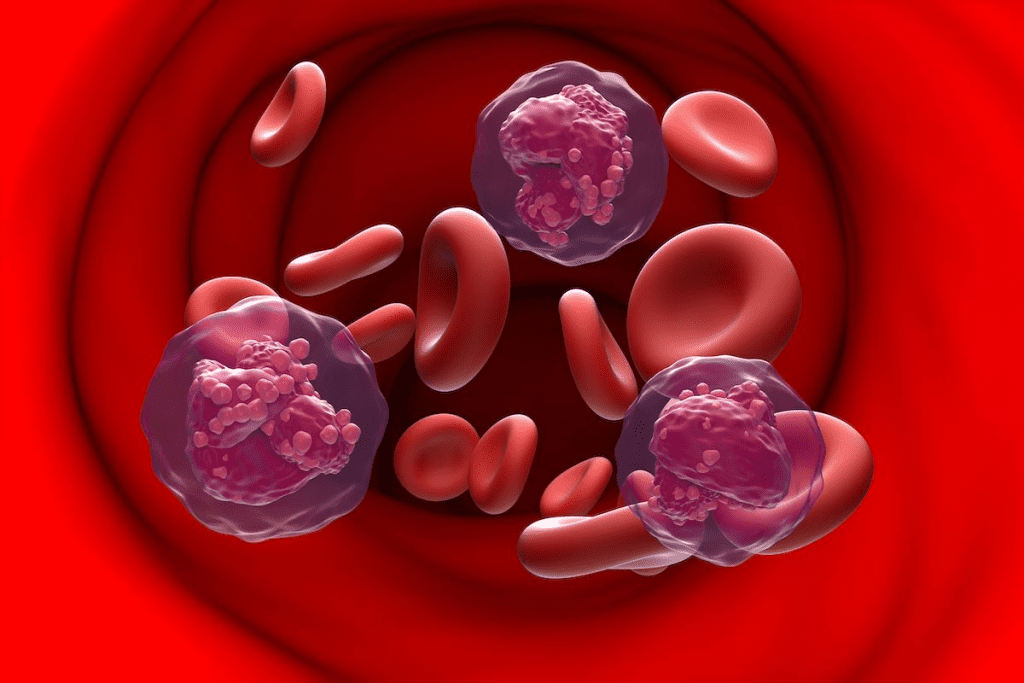Last Updated on November 13, 2025 by Bilal Hasdemir
Learn about benzene leukemia and the dangerous, powerful environmental chemical exposures linked to blood cancer.
Leukemia is a blood cancer linked to certain chemicals. Research shows specific substances raise the risk of this disease. Knowing these risks is key to prevention and care.

Certain chemicals, like known carcinogens like benzene, increase leukemia risk in kids and adults. Glyphosate-based herbicides and PFAS also raise this risk. At LivHospital, we use top international protocols to lower exposure and risk.
It’s important to understand how chemicals can lead to leukemia. This knowledge helps us find ways to prevent it. Leukemia, a blood cancer, is linked to certain chemicals in our environment and workplaces. These chemicals harm our bone marrow and blood cells, causing leukemia.
Chemicals like benzene harm the bone marrow, where blood cells are made. Benzene exposure can lower blood cell production, raising leukemia risk. “Benzene is a known cause of leukemia and other blood disorders,” experts say.

Chemicals like benzene damage blood cell DNA. This damage causes cells to grow uncontrollably, a sign of cancer. Formaldehyde, another harmful chemical, is also linked to leukemia. The exact ways it causes leukemia are being studied.
Being exposed to chemicals like benzene increases leukemia risk. But some people are more at risk due to genetic factors, age, or past exposure to radiation or other harmful substances. “Those with a family history of leukemia or other cancers may be at higher risk,” research shows.
Knowing these risk factors helps us create better prevention plans. We must consider these factors when looking at the risk of leukemia from chemical exposure.
Benzene is a known carcinogen linked to an increased risk of leukemia, mainly acute myeloid leukemia (AML). It’s found in many industrial and consumer products. This makes exposure a big public health worry.

Benzene is everywhere in our environment. It can get into our bodies in different ways. Here are some main sources:
People who work with benzene or products that have it are at higher risk. This includes workers in the petroleum, chemical, and transportation industries.
Many studies have shown benzene’s link to leukemia. Epidemiological studies have found a strong connection. For example, a study in the Journal of the National Cancer Institute found a big increase in AML risk among benzene-exposed workers.
Mechanistic studies have shown how benzene might cause leukemia. It harms bone marrow and disrupts blood cell production. This can lead to genetic mutations and leukemia.
The International Agency for Research on Cancer (IARC) has classified benzene as “carcinogenic to humans.” This confirms the link between benzene and leukemia. As more research comes out, it’s clear we need to reduce benzene exposure to prevent leukemia.
Formaldehyde is a chemical found in many products. It’s used in construction, manufacturing, and healthcare. Because it’s everywhere, knowing its health risks is important.
Formaldehyde is in many things. It’s in wood products like plywood and particleboard. It’s also in plastics, coatings, and textiles. You can find it in homes, workplaces, and schools.
It’s also a byproduct of burning things. This includes cars, factories, and even cooking.
Children are more at risk because their bodies are growing. They spend more time inside, where formaldehyde builds up. They might touch or eat things with formaldehyde. It’s key to lower formaldehyde in places where kids hang out.
To cut down on formaldehyde, pick products without it. Make sure places have good air flow. Use air cleaners that get rid of formaldehyde. These steps help keep kids safe from danger.
The use of agricultural chemicals is growing worldwide. It’s key to know how they might raise the risk of leukemia. We look into the dangers and how to stay safe.
Glyphosate herbicides have been around for years. Research links them to a higher leukemia risk. Studies show glyphosate can harm DNA and mess with cell function, which might cause cancer.
The International Agency for Research on Cancer (IARC) says glyphosate might cause cancer in humans. This makes it critical for those working with these chemicals to be careful.
Parents exposed to pesticides might increase their kids’ leukemia risk. Research shows that kids of parents exposed to pesticides are more likely to get leukemia. It’s vital to limit exposure, mainly for pregnant women and young kids.
Agricultural workers and communities can lower their pesticide exposure. Wearing protective gear, handling chemicals safely, and sticking to limits can help.
Knowing the risks of agricultural chemicals and taking steps to protect ourselves can help fight leukemia linked to these exposures.
Other chemicals are now being looked at for their link to leukemia, aside from known carcinogens like benzene. It’s key to study new contaminants that could harm our health. This helps us understand how chemicals might cause leukemia.
Asbestos is known to cause lung cancer and mesothelioma. But research shows it might also raise leukemia risk. People exposed to asbestos are more likely to get leukemia, such as acute myeloid leukemia (AML).
The exact way asbestos leads to leukemia isn’t clear. But, it’s thought that asbestos fibres damage bone marrow cells. This can lead to cancerous changes.
The link between asbestos and leukemia highlights the need for strict monitoring and rules. It’s important to reduce asbestos exposure. This can help prevent lung cancer, mesothelioma, and possibly leukemia.
Mold toxins, like aflatoxins, are linked to health issues, including cancer. While aflatoxins are mainly associated with liver cancer, new studies suggest they might also cause blood cancers like leukemia. This could be due to weakened immunity and genetic damage.
Research on mold toxins and leukemia is growing. It’s vital to learn how we get exposed and the health risks. Lowering mold toxin exposure can help protect our health. This includes keeping buildings dry and storing food properly.
As we dig deeper into leukemia causes, it’s clear that new chemicals like asbestos and mold toxins are key. By learning about these risks and reducing exposure, we can fight leukemia and improve health.
It’s important to know how chemicals can lead to leukemia. Benzene and formaldehyde are two big culprits. They can cause benzene leukemia and formaldehyde-related leukemia.
To lower your risk, start by avoiding cigarette smoke and wearing protective gear at work. Knowing where benzene and formaldehyde are found helps us stay safe.
Small actions can make a big difference. Following safety rules and wearing the right gear can cut down chemical exposure. Let’s all work together to make our environment safer and lower the risk.
Benzene, formaldehyde, glyphosate-based herbicides, and PFAS are linked to leukemia risk.
Yes, benzene exposure raises the risk of leukemia, mainly acute myeloid leukemia (AML).
Formaldehyde exposure increases leukemia risk. Children are more vulnerable.
Asbestos is a known carcinogen. It can cause lung cancer and mesothelioma. It may also increase leukemia risk.
Mold toxins, like aflatoxins, may increase cancer risk, including leukemia.
To reduce exposure, know where benzene and formaldehyde come from. Use protective gear and follow safety rules, mainly at work.
Yes, workers and communities near farms face higher risks from pesticides and herbicides. They should protect themselves.
Glyphosate-based herbicides increase leukemia risk. Workers and communities should be cautious.
Subscribe to our e-newsletter to stay informed about the latest innovations in the world of health and exclusive offers!